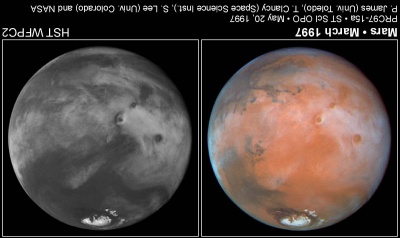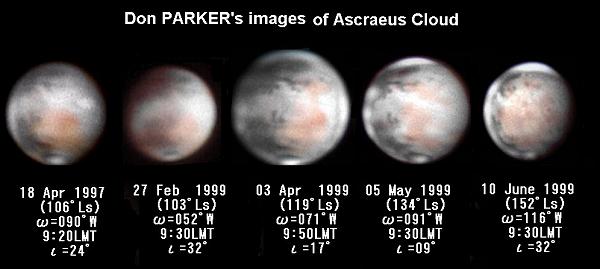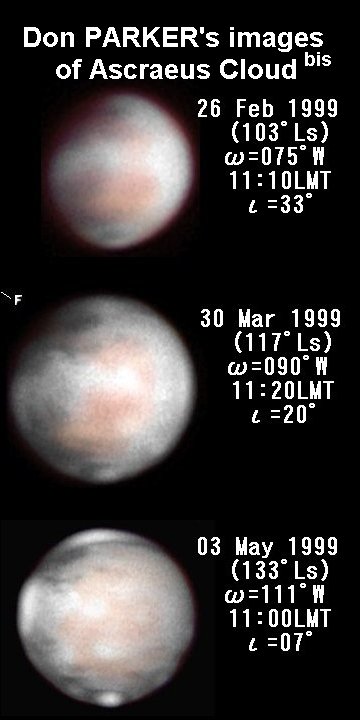98/99 Mars CMO Note (11)
1998/99 Mars CMO Note
- 11 -
from CMO #232
Trend of the Ascraeus white cloud
A newly defined notion of "Ascraeus" Cloud was introduced in a Note at p2465 in CMO #215 (10 Apr 1999 issue) as the one denoting a roundish white cloud/mist which was seen at the following outskirts of Ascraeus Mons through the valley upto the preceding area of Olympus Mons. In 1997, this cloud was witnessed conspicuously at the season 098°Ls on 31 Mar 1997 at Fukui (Mn-464D ~ Mn-473D). On the preceding day on 30 Mar 1997 (097°Ls), the HST produced a clear and detailed image of the cloud at about LCM=094°W (cf CMO #191 & #211). Since the longitudes of Ascraeus Mons and Olympus Mons are at longitude=104°W and longitude=133°W respectively, the longitude of the Ascraeus Cloud can be regarded as being around longitude=120°W.
HST's images on 30 Mar 1997
(097°Ls) LCM=094°W
 In 1997 the planet was at opposition on 18 Mar and the phase angle at the end of March was the phase angle=11°, and hence the Local Martian Time (LMT) of the cloud can be roughly pinned down as follows; the linelongitude=120°W is separated from the noon line by 120-94+11=37° which implies 37/15=2.5h in hours, and so the LMT must be near 9:30 am. The drawing Mn-471D on 31 Mar 1997 also shows the similar LMT.
In 1997 the planet was at opposition on 18 Mar and the phase angle at the end of March was the phase angle=11°, and hence the Local Martian Time (LMT) of the cloud can be roughly pinned down as follows; the linelongitude=120°W is separated from the noon line by 120-94+11=37° which implies 37/15=2.5h in hours, and so the LMT must be near 9:30 am. The drawing Mn-471D on 31 Mar 1997 also shows the similar LMT.
We also note a CCD image obtained by Gianni QUARRA (GQr) on 8 Apr 1997 (101°Ls) at LCM=091°W shows evidently the presence of the Ascraeus Cloud (cf the image in CMO #201 p2246).
The valley cloud diurnally forms thickly at dawn and is weakened in the afternoon, and will be taken the place by the evening orographic cloud covering Ascraeus Mons. In 1997 for a time being this process was observed to repeat every Martian day. The observations in 1999 provided a hint as to how the phenomenon remained and decayed during the season.
This Ascraeus Cloud can also be identified with the ones observed in the early 1980's. The present write (Mn)'s drawings made on 18 and 19 April 1982 (114°Ls) by the use of 450x 15cm refractor at Fukui show the phenomenon. The phase angle was 15° after opposition. The LCM=092°W so implied 9:10 LMT when the cloud was conspicuous. The cloud was visible also at LCM=132°W near noon. (The drawing on 18 Apr 1982 LCM=092°W is found in CMO #201 p2247.)
In 1984, before opposition at the end of March the season was already 126°Ls, and so the apparent diameter was not enough and also the observation rate was low without definite observations. At the beginning of May 1984, the apparent diameter became enough up to 17.0" while no definite cloud was observed perhaps because the season 143°Ls at that time was already late.
The 1999 apparition was similar to the one in 1984, and so it was no more suited for the watching of the height of the Ascraeus Cloud because the apparent diameter was still 11.5" when the season was 109°Ls in mid-March (when the area faced to us in Japan). This implied it was appropriate in 1999 to watch the decay period of the phenomenon. In mid-April we observed the white cloud on 14 Apr 1999 (124°Ls) at LCM=115°W (Mn-399D) and so on. We also observed again the area from 16 May (140°Ls) as will be touched later.
We aim here at plotting the rise and fall of the Ascraeus Cloud especially depending on the observations by Don PARKER (DPk) because his CCD work was done successively from the earlier stage in 1999.
We will conclude in the following by referring also to our observations that the Ascraeus Cloud at 9:30 am LMT remains in the heyday from 095°Ls to 120°Ls, while it becomes weaker at 135°Ls and almost decays at 140°Ls.
The first column here consists of the images by PARKER (DPk) where each image is from around 9:30 LMT. The phase angle differs one another and so note that the noon line usually differs from the LCM:

(1) The first image was taken in 1997 on 18 April and the season was 106°Ls. This was shot later than HST's image on 31 Mar 1997 (098°Ls) and slightly later than GQr's image on 8 Apr (101°Ls), but the white cloud is well visible.
(2) The next one is on 27 Feb 1999 (103°Ls) at LCM=052°W when the apparent diameter was only 10.2": The image is not sharp enough, but we may say the cloud is thick (especially in B).
(3) The third image is on 3 Apr 1999 (119°Ls) LCM=071°W. The time was 9:50 LMT, but the cloud is still thick.
(4) Notable however is that the image on 5 May 1999 (134°Ls) at LCM=091°W (at 9:30 LMT) shows a less thick cloud. The observations by DPk on 7 May 1999 (135°Ls) show that at LCM=072°W (at 8:00 LMT) the cloud looked still thick, but soon it became rapidly weaker.
(5) Finally the image on 10 June 1999 (152°Ls) does not prove the existence of the Ascraeus Cloud at 9:30 LMT.
From our side, the valley region came into sight from 16 May 1999 (140°Ls) at LCM=108°W (10:00 LMT) but looked free from the cloud. So we can judge the season 140°Ls must be a limit. The drawing shown at p2715 in #230 which we took on 21 May 1999 (142°Ls, the phase angle=21°) at LCM=081°W shows no more Ascraeus Cloud though the area was at 8:00 LMT. The B image corresponding to the CCD image at p2717 by DPk on 14 June 1999 (154°Ls, the phase angle=37°) at LCM=081°W does never produce the white patch while it was taken earlier at 7:00 LMT.
 The second file here shown consists of DPk's images at 11:00 LMT: On the image on 30 Mar 1999 (at 117°Ls) the Ascraeus Cloud is thick even at 11:30 LMT, while the cloud in question on 3 May 1999 (at 133°Ls) looks weak at 11:00 LMT and rather splits into two: one is to the side of Ascraeus Mons and the other to Olympus Mons orographically (the summit of Ascraeus Mons already moved to the afternoon side). We say on 30 Mar (at 117°Ls, the phase angle=20°) the valley already turned to be reddish even at LCM=109°W because the valley was towards the afternoon side.
The second file here shown consists of DPk's images at 11:00 LMT: On the image on 30 Mar 1999 (at 117°Ls) the Ascraeus Cloud is thick even at 11:30 LMT, while the cloud in question on 3 May 1999 (at 133°Ls) looks weak at 11:00 LMT and rather splits into two: one is to the side of Ascraeus Mons and the other to Olympus Mons orographically (the summit of Ascraeus Mons already moved to the afternoon side). We say on 30 Mar (at 117°Ls, the phase angle=20°) the valley already turned to be reddish even at LCM=109°W because the valley was towards the afternoon side.
We thus traced the seasonal change of the rise and fall of the Ascraeus Cloud seen around at 9:30 am LMT. Diurnally, before dawn of Olympus Mons, there appears a thick whitish patch following the outskirts of Ascraeus Mons over a rather lower ground or valley, and it remains to stay thickly all the morning. Its seasonal peak arrives at the season 095°Ls~120°Ls. The cloud becomes however dispersed even at 9:30 LMT from around 140°Ls.
An earlier trend of the Cloud before the height might be found in the observations in 1996/97. For example DPk's image on 13 Mar 1997 (at 090°Ls, the phase angle=04°) at LCM=078°W shows the time 9:30 LMT of the line longitude=120°W. It is difficult to judge but the white patch shown there must be related with Olympus Mons, and the Ascraeus Cloud was just ahead and was not so thick. The HST image taken on 30 Dec 1996 (at 058°Ls) at LCM=045°W does not seem to show the cloud in question.
The example here treated being different in structure from the one known as the orographic cloud that becomes apparent in the afternoon at the high-levelled mountain. This is an example of larger and rather dispersed ones seen in a certain season in the morning around at the lower areas pinched by the higher mountains.
(Mn)
 In 1997 the planet was at opposition on 18 Mar and the phase angle at the end of March was the phase angle=11°, and hence the Local Martian Time (LMT) of the cloud can be roughly pinned down as follows; the linelongitude=120°W is separated from the noon line by 120-94+11=37° which implies 37/15=2.5h in hours, and so the LMT must be near 9:30 am. The drawing Mn-471D on 31 Mar 1997 also shows the similar LMT.
In 1997 the planet was at opposition on 18 Mar and the phase angle at the end of March was the phase angle=11°, and hence the Local Martian Time (LMT) of the cloud can be roughly pinned down as follows; the linelongitude=120°W is separated from the noon line by 120-94+11=37° which implies 37/15=2.5h in hours, and so the LMT must be near 9:30 am. The drawing Mn-471D on 31 Mar 1997 also shows the similar LMT.
 The second file here shown consists of DPk's images at 11:00 LMT: On the image on 30 Mar 1999 (at 117°Ls) the Ascraeus Cloud is thick even at 11:30 LMT, while the cloud in question on 3 May 1999 (at 133°Ls) looks weak at 11:00 LMT and rather splits into two: one is to the side of Ascraeus Mons and the other to Olympus Mons orographically (the summit of Ascraeus Mons already moved to the afternoon side). We say on 30 Mar (at 117°Ls, the phase angle=20°) the valley already turned to be reddish even at LCM=109°W because the valley was towards the afternoon side.
The second file here shown consists of DPk's images at 11:00 LMT: On the image on 30 Mar 1999 (at 117°Ls) the Ascraeus Cloud is thick even at 11:30 LMT, while the cloud in question on 3 May 1999 (at 133°Ls) looks weak at 11:00 LMT and rather splits into two: one is to the side of Ascraeus Mons and the other to Olympus Mons orographically (the summit of Ascraeus Mons already moved to the afternoon side). We say on 30 Mar (at 117°Ls, the phase angle=20°) the valley already turned to be reddish even at LCM=109°W because the valley was towards the afternoon side.